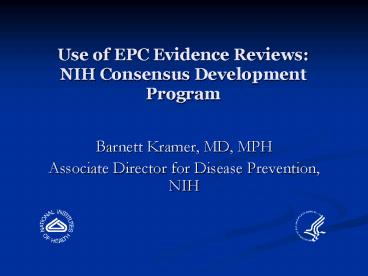Use of EPC Evidence Reviews: NIH Consensus Development Program - PowerPoint PPT Presentation
1 / 11
Title:
Use of EPC Evidence Reviews: NIH Consensus Development Program
Description:
Produce an unbiased, evidence-based assessment of a ... Nominate Speakers. Nominate Panelists. Set Agenda. Set Conference. Title/Date. AHRQ Evidence Report ... – PowerPoint PPT presentation
Number of Views:35
Avg rating:3.0/5.0
Title: Use of EPC Evidence Reviews: NIH Consensus Development Program
1
Use of EPC Evidence ReviewsNIH Consensus
Development Program
- Barnett Kramer, MD, MPH
- Associate Director for Disease Prevention, NIH
2
Consensus Development Program
- GOAL
- Produce an unbiased, evidence-based assessment
of a complex/controversial medical issue that
will advance understanding for health
professionals and the public.
3
Levels of Decision Making
- Level I Would you have this done for
yourself or for someone else in your immediate
family? - Influenced by ones personal experience with
the disease and capacity to deal with risk. - Affects few people.
- Level II What would I recommend to my
patient/client? - Physician making a recommendation for his/her
patients. Influenced by prior experience, but
the scientific evidence may play a greater role. - Affects possibly hundreds of people.
- Level III What would I recommend to the nation,
the world? - Across-the-board recommendations for a
population. - Must be based on rigorous assessment of the
scientific evidence. - Affects hundreds of thousands, even millions of
people. - slide courtesy of Leon Gordis, M.D.., Johns
Hopkins University
4
Consensus Development Program
- Audiences
- Health Professionals
- Public
- Research Agencies
5
EPC reports for OMAR
- Osteoporosis
- ERCP
- Management of Hepatitis C
- Management of Cancer Symptoms
- Management of Clinically Inapparent Adrenal Mass
- Total Knee Replacement
- Youth Violence
- Improving End-of-life Care
- Management of Menopausal Symptoms
- Cesarean Delivery on Maternal Request
- Multivitamin/Mineral Supplements and Chronic
Disease - Tobacco Prevention, Cessation, and Control
- And More
6
A Consensus Development Conference is NOT simply
an evidence report
Expert speaker testimony
Systematic evidence review
Public (audience) input
PANEL
Consensus Statement
7
Selection CriteriaNIH Consensus Development
Conferencevs.State-of-the-Science Conference
- Public health importance
- Gap between knowledge and practice
- Amenable to clarification
- Strength of available evidence
- State-of-the-Science Consensus
X X
X X
X X
X
8
RCTs Dbl Blind
Stronger Evidence
RCTs
Cohort Studies
Case Control Studies
Weaker Evidence
Case Series
Case Reports
Ideas Opinions
State-of-the-Science Conference
Consensus Conference
Identical Conference Process
Consensus Conference Statement Focused on
Practice Recommendations
State-of-the-Science Statement Focused on
Research Agenda
9
NIH Consensus Development Process
Topic Proposal from Institute or Center
NIH Organizational Meeting
Finalize Questions Nominate Speakers Nominate
Panelists Set Agenda Set Conference Title/Date
Planning Committee (Experts, Institutes,
Agencies)
AHRQ Evidence Report
Panelists Meet Pre-Conference (Panelists are
independent, non-DHHS, general expertise, but
not doing research on the issues at hand)
Review AHRQ report
14 Months
Expert Testimony (Speakers)
Conference
Public Input (Discussion Periods)
Press Conference Draft Statement Posted on Web
(http//consensus.nih.gov)
10
The Panel
11
On Behalf of NIH, Thank You!































